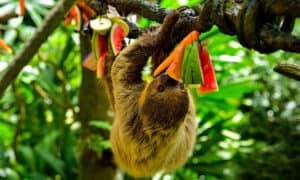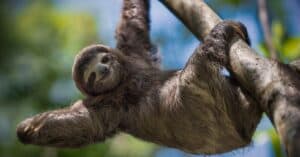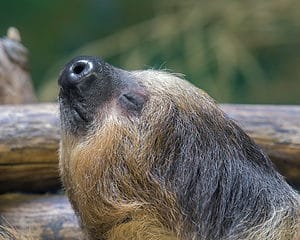The world’s most famously sluggish mammal, the sloth, is also one of the cutest. Sloths get their moniker from their slow metabolism and methodical motions. Sloth, like slow, literally means “laziness,” and it is commonly used in various other languages. These mammals are so slow, in fact, that when they were first reported in scholarly literature in 1749, they were dubbed as “the slowest form of existence.” Pretty harsh, right? Since then, we’ve discovered that sloths are far from basic, sluggish creatures who sleep all day.
Do you want to know more about these lovely slowpokes? We’ve got the lowdown on the sloth lifespan and other intriguing facts about them to give you a glimpse into the mysterious existence of the sloth.
Quick Crash Course On Sloths
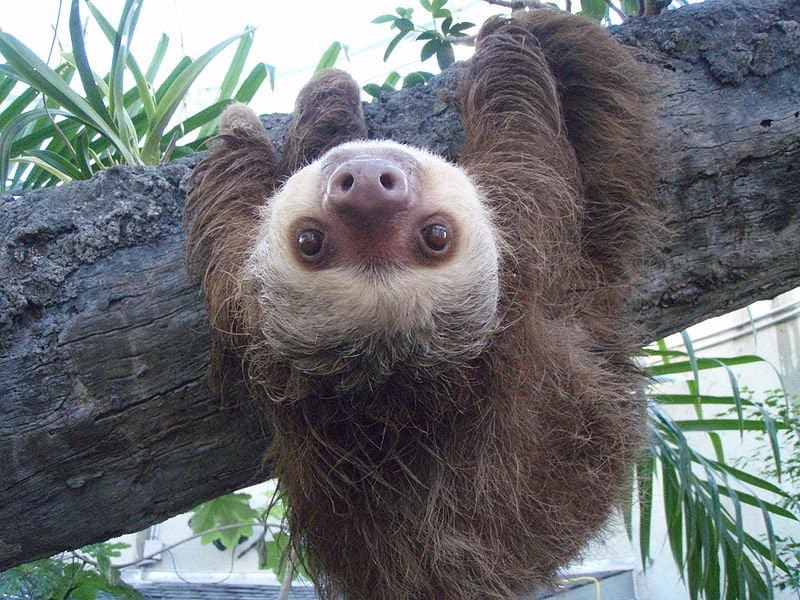
Sloths can be found lazily exploring the jungles of Central and South America.
©Ontley, CC BY-SA 3.0, via Wikimedia Commons – License
Sloths are a kind of Neotropical xenarthran mammal that lives in the trees. They are known for their slow movements. Their response time is roughly a fourth that of a human’s, and they travel at a speed of 6 to 8 feet per minute. They spend much of their lives hanging upside down in the trees of tropical rainforests of South and Central America. Despite being slow on land, they are quite fast in the water. Sloths are excellent swimmers. They can go across the water at three times the speed they can on land.
However, their slowness is actually an evolutionary way of surviving out in the wild. Sloths eat mostly leaves, and their four-part stomachs may digest a single meal for up to a month. Because the leafy greens aren’t very nutritious, they must preserve as much energy as possible in order to survive—which means moving less. As an added advantage, their sluggish movements allow them to avoid detection by predators that rely on sight to pursue prey, such as jaguars, ocelots, and harpy eagles.
Both two-toed and three-toed sloths descended from massive ground sloths, the greatest of which weighed several tons and reached around 12 feet tall. The creatures became extinct around 10,000 years ago, most likely as a result of hunting by early humans.
Let’s explore the sloth lifespan next!
How Long Do Sloths Live?
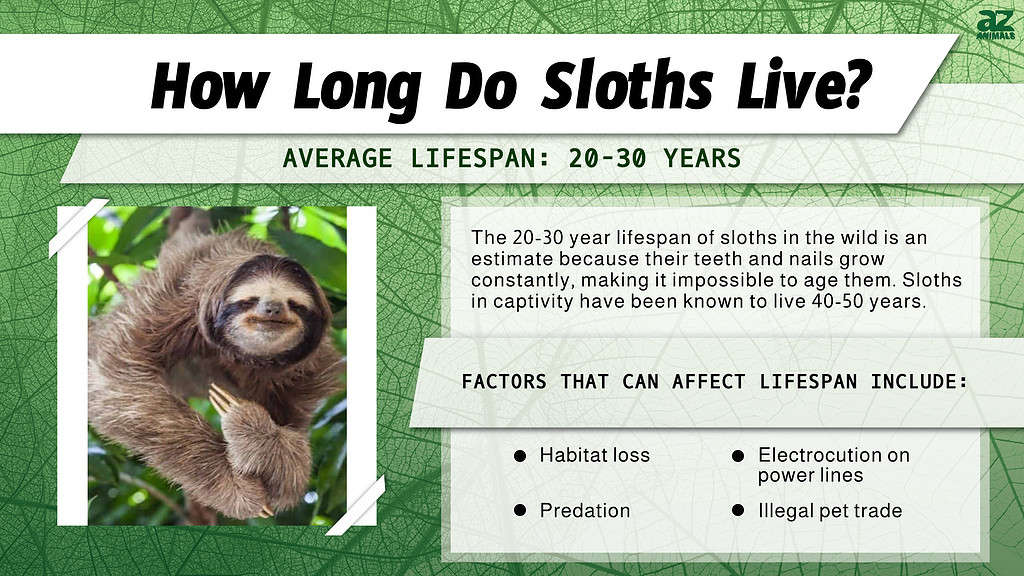
The average sloth lifespan is roughly 20-30 years in the wild. However, because the sloth’s teeth and nails grow continually throughout their lives, determining the age of a wild sloth is impossible. The fact is that we don’t know how long they can live in the wild.
In captivity, sloths have been known to live much longer than rough estimates as well. Two-fingered sloths (Choloepus) in captivity can live for 40-50 years. One sloth at the Smithsonian Institution’s National Zoo lived for 49 years before dying. However, due to the lack of the ability to breed sloths in captivity until 50 years ago, there has been little chance for any individual to exceed this number.
Furthermore, no one has ever tracked a wild sloth from birth to death. Therefore, all estimates of wild sloth longevity are predicated on a lack of verifiable data.
The Average Sloth Life Cycle
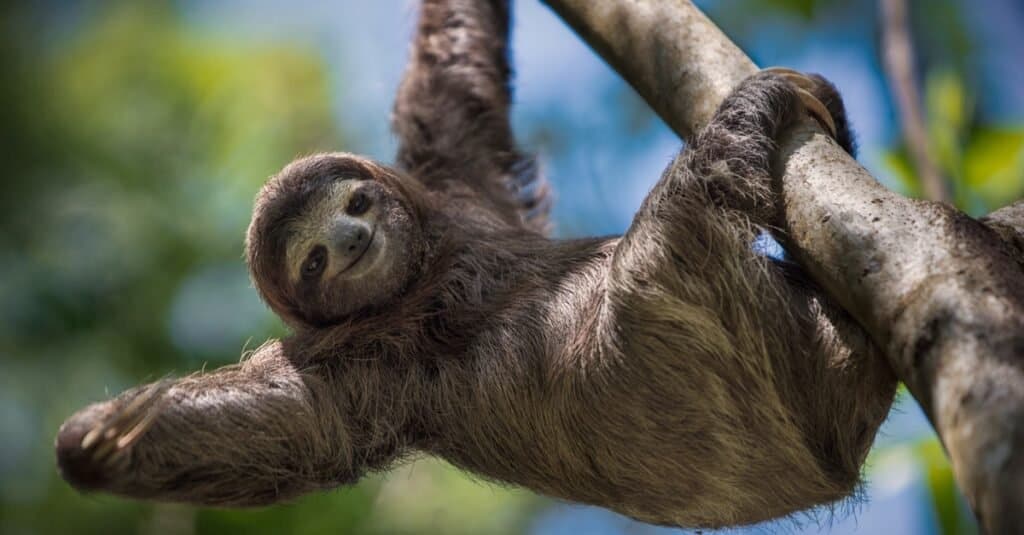
Sloths can live between 20 to 30 years in the wild.
©jdross75/Shutterstock.com
Now that we have a better understanding of the sloth’s lifespan, let’s look at their life cycle. While sloth sex is still a mystery to scientists, reproductive tactics differ between two-toed and three-toed sloth species. Let’s take a look at this fascinating cycle in more detail.
Gestation
Each sloth species has a different gestation time. Typically, each sloth species only has one young at a time. The gestation period of the brown-throated three-toed sloth is around 150 days. The gestation span of a Hoffman’s two-toed sloth is 11.5 months. The gestation period of Linnaeus’ two-toed sloth is six months. Regardless of species, all sloths give birth upside down under the canopy of a tree.
Baby Sloths
Sloths give birth under the tree canopy. Their newborns are born with claws. The sloth’s solitary youngster sticks to its mother until it is able to feed alone. This stage lasts five months for Hoffman’s two-toed sloths. Baby sloths cling to their mothers’ abdomens until they are strong enough to hang upside down on their own, which takes around three weeks after birth.
For two years, Hoffman’s two-toed sloth newborns stay with their mothers. Male pale-throated three-toed sloths do not actively participate in the lives of their partners or children. This means that juvenile sloths acquire their dietary habits, survival strategies, and overall behavioral tendencies from their mothers.
Adulthood
The female sloth reaches maturity before the male sloth. Male Hoffman’s two-toed sloths attain adulthood between the ages of 4 and 5 years, while females achieve maturity at 3.5 years. Mature Hoffman’s two-toed sloths weigh 9 to 19 pounds, measure 21 to 29 inches in length. A mature brown-throated three-toed sloth weighs 8 to 9 pounds, measures 20 to 21 inches long, and has a 1.5 to 2-inch tail. Linnaeus’ two-toed sloths reach maturity between the ages of three and five years.
What Factors Impact The Sloth Lifespan
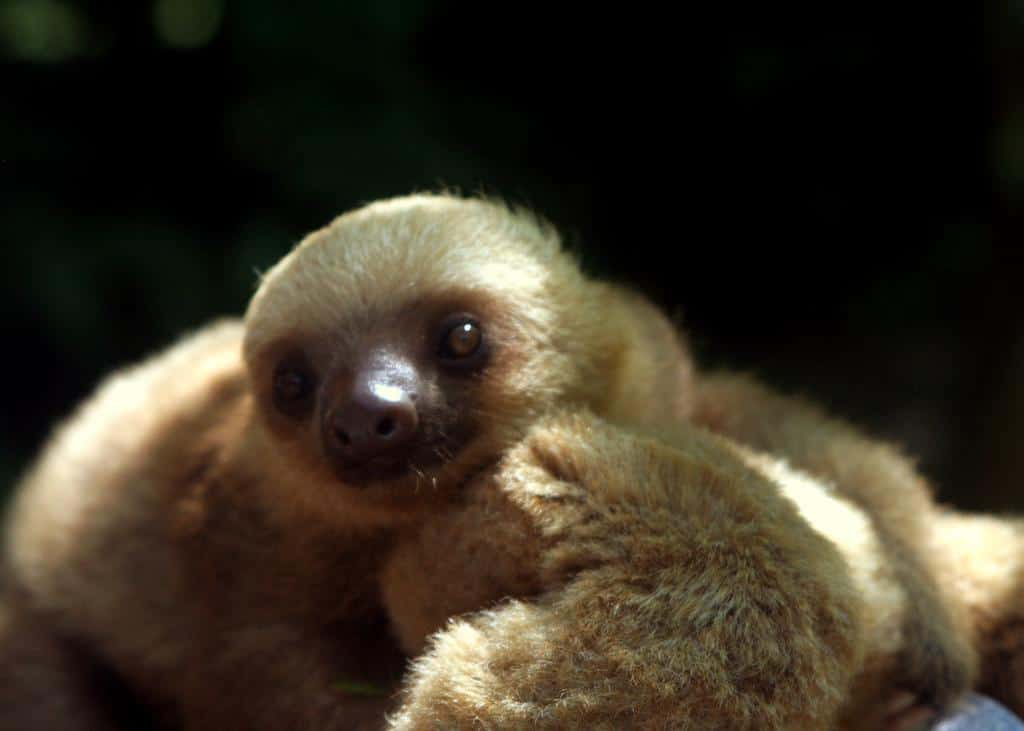
Sloths are threatened by habitat loss, electrocution on power lines, and predation.
©Dave Gingrich / CC BY-SA 2.0, Flickr – License
Sloths play an important role in tropical rainforest ecosystems. They benefit the ecosystem by devouring tree leaves, which let sunlight into the jungle. They also fertilize trees by defecating at their roots. However, there are several factors that threaten the lifespan of the sloth in the wild.
These factors include:
- Habitat loss: The number one danger for many wild sloth populations is habitat loss. Because sloths are physiologically incapable of traversing large gaps between trees, they rely on a continuous rainforest canopy for existence. As people expand farther into the rainforest, more trees are chopped down and the forest is divided, making sloths vulnerable.
- Electrocution on power lines: According to the Sloth Conservation Foundation, every year, more than 3000 wildlife electrocutions occur in Costa Rica. The majority of electrocuted animals are sloths and the survival rate is only 25% after electrocution.
- Predation: Sloths have a variety of predators that prey upon them. Some of their biggest threats include harpy eagles and jaguars.
The photo featured at the top of this post is © Janossy Gergely/Shutterstock.com
Thank you for reading! Have some feedback for us? Contact the AZ Animals editorial team.




